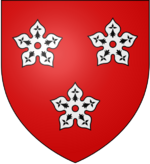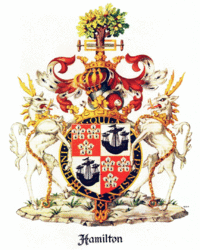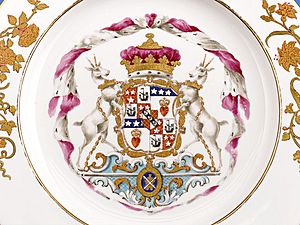Duke of Hamilton facts for kids
Quick facts for kids Dukedom of Hamiltonheld with Dukedom of Brandon |
|
|---|---|
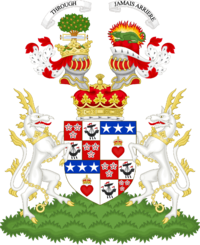
Quarterly, first and fourth grandquarters counterquartered, first and fourth gules, three cinquefoils ermine (for Hamilton); second and third argent, a lymphad with sails furled proper, flagged gules (for Arran); second and third grandquarters argent, a heart gules imperially crowned proper, on a chief azure three stars of the field (for Douglas).
|
|
| Creation date | 12 April 1643 |
| Monarch | Charles I |
| Peerage | Peerage of Scotland |
| First holder | James Hamilton, 3rd Marquess of Hamilton |
| Present holder | Alexander Douglas-Hamilton, 16th Duke |
| Heir apparent | Douglas Charles Douglas-Hamilton, Marquess of Douglas and Clydesdale |
| Remainder to | heirs male of the body of the grantee; the grantee's brother; heirs male of the body of the grantee's brother; the grantee's eldest daughter, followed by her heirs male; nearest heirs whatsoever of the grantee |
| Subsidiary titles | Marquess of Douglas Marquess of Clydesdale Earl of Angus Earl of Lanark Earl of Arran and Cambridge Lord Abernethy and Jedburgh Forest Lord Machanshire and Polmont Lord Aven and Innerdale Baron Dutton |
| Status | Extant |
| Seat(s) | Lennoxlove House |
| Former seat(s) | Hamilton Palace Brodick Castle Dungavel House Kinneil House Ashton Hall Ferne House Cadzow Castle |
The Duke of Hamilton is a very old and important title in Scotland. It was first created in April 1643. This duke is the most senior (highest-ranking) duke in Scotland, except for the Duke of Rothesay, which is a title held by the King's oldest son.
Being the Duke of Hamilton means you are the head of two major Scottish families: the House of Hamilton and the House of Douglas. The town of Hamilton in Scotland, and many other places around the world, are named after members of the Hamilton family.
The family's original last name was "Hamilton," but it is now "Douglas-Hamilton". Since 1711, the Duke of Hamilton has also held the title of Duke of Brandon in Great Britain. This is why the dukes are often called Duke of Hamilton and Brandon. They also have several other smaller titles.
Contents
What Titles Does the Duke Hold?
The current Duke of Hamilton and Brandon holds many titles. These titles come from different historical periods and different peerages (systems of nobility).
Scottish Titles
- 16th Duke of Hamilton (created 1643)
- 13th Marquess of Douglas (created 1633)
- 16th Marquess of Clydesdale (created 1643)
- 23rd Earl of Angus (created 1389)
- 13th Earl of Angus (created 1633)
- 15th Earl of Lanark (created 1639)
- 16th Earl of Arran and Cambridge (created 1643)
- 13th Lord Abernethy and Jedburgh Forest (created 1633)
- 15th Lord Machanshyre and Polmont (created 1639)
- 16th Lord Aven and Innerdale (created 1643)
British Titles
- 13th Duke of Brandon, in the County of Suffolk (created 1711)
- 13th Baron Dutton, in the County of Chester (created 1711)
Special Duties of the Duke
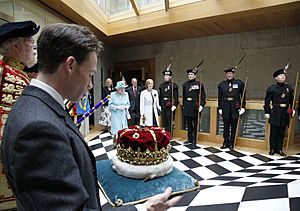
The Duke of Hamilton and Brandon has some special jobs. He is the hereditary (passed down through the family) keeper of the Palace of Holyroodhouse. This is the official royal home in Scotland. The Duke even has large private rooms there.
He is also the hereditary bearer of the Crown of Scotland. This means he carries the Crown during important ceremonies. For example, the 15th Duke carried it when the Scottish Parliament opened in 1999. The 16th Duke did the same in 2011. He also placed the crown on Queen Elizabeth II's coffin in 2022.
Traditionally, the Duke of Hamilton is the only person allowed to remove the Scottish Crown Jewels from Edinburgh. He also helps out in the Court of Lord Lyon, which deals with Scottish heraldry (coats of arms).
Courtesy Titles for Heirs
In noble families, the oldest son often uses a "courtesy title" before he inherits the main title. The oldest son of the Duke of Hamilton and Brandon is called "Marquess of Douglas and Clydesdale". The oldest son of that Marquess would be called "Earl of Angus".
If there were a great-grandson in line, he would likely be called "Lord Abernethy". These titles help show who is next in line to inherit the dukedom.
Dukes with Multiple Dukedoms
The Duke of Hamilton and Brandon is one of only five British peers (noblemen) who hold more than one dukedom. The others are:
- The Prince of Wales (who is also Duke of Cornwall, Duke of Rothesay, and Duke of Cambridge).
- The Duke of Buccleuch and Queensberry.
- The Duke of Argyll (who holds two Dukedoms of Argyll).
- The Duke of Richmond, Lennox, and Gordon.
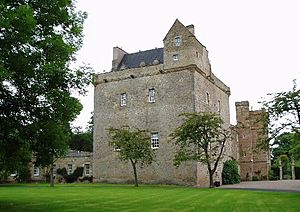
The Hamilton Family History
The Hamilton family has a long and interesting history in Scotland.
Early Lairds of Cadzow
The first known ancestor, Gilbert de Hameldun, lived in the late 1200s. His family's origins are not fully clear. Gilbert's heir was Walter fitz Gilbert. He was in charge of Bothwell Castle for the English King.
After the Battle of Bannockburn in 1314, Walter switched sides to support Robert the Bruce. King Robert then made him a knight and gave him lands, including Cadzow. Cadzow is now the town of Hamilton.
Walter's son, Sir David fitz Walter, continued to support the Scottish King. He was even captured with King David II at the Battle of Neville's Cross. His son, David Hamilton, was the first to officially use "Hamilton" as the family name.
Lords Hamilton and Earls of Arran
Sir James Hamilton, the 6th Laird of Cadzow, was made a Lord of Parliament in 1445. This meant he could attend the Scottish Parliament. He married Princess Mary, daughter of King James II.
His son, James, 2nd Lord Hamilton, became an important advisor to King James IV. As a reward, he was made Earl of Arran in 1503.
His son, James, 2nd Earl of Arran, was Regent of Scotland (ruler while the Queen was young) from 1542 to 1554. He was the guardian of the young Mary, Queen of Scots. He was also given the title of Duc de Châtellerault in France.
Marquesses and Dukes of Hamilton
The 2nd Earl's younger brother, John Hamilton, was made Marquess of Hamilton in 1599. His son, James, 2nd Marquess of Hamilton, moved to England with King James VI. He also became an Earl in England.
His son, James, 3rd Marquess of Hamilton, was made Duke of Hamilton in 1643. This was a very high honor. The special rules for this dukedom meant that it could be passed down through the female line if there were no male heirs.
When the 1st Duke and his brother (the 2nd Duke) both died without sons, the title went to the 1st Duke's daughter, Anne, 3rd Duchess of Hamilton. She was a very important figure.
In 1656, the 3rd Duchess married William Douglas. He changed his last name to "Hamilton" and was also made Duke of Hamilton for his lifetime.
In 1698, the 3rd Duchess gave her titles to her oldest son, James. He became the 4th Duke. He was a leader against the union of Scotland and England in 1707. In 1711, he was also made Duke of Brandon in Great Britain. He died in a famous duel in London in 1712.

The Dukedom then passed through several generations. In 1761, the 7th Duke inherited more titles from the Douglas family, becoming the head of both the Hamilton and Douglas families. The current Duke, Alexander, 16th Duke of Hamilton, inherited the title in 2010.
How the Dukedom of Hamilton is Passed Down
The original document that created the Dukedom of Hamilton had special rules for who would inherit it:
- First, it would go to the sons of the first Duke.
- If no sons, then to the first Duke's brother and his sons.
- If still no sons, then to the first Duke's oldest daughter and her sons.
- If all else failed, to the closest heirs of the first Duke.
Since the first two Dukes died without sons, the title has been passed down through the third rule since 1651. This means it went to the first Duke's daughter (the 3rd Duchess) and then to her male descendants.
The Douglas Family History
The Douglas family is another ancient and powerful Scottish family. George Douglas, an illegitimate son of the 1st Earl of Douglas, was made Earl of Angus in 1389.
Later, William, the 11th Earl of Angus, was made Marquess of Douglas in 1633. His great-grandson, Archibald, 3rd Marquess of Douglas, was made Duke of Douglas in 1703.
When the Duke of Douglas died without children in 1761, his Dukedom ended. However, his other titles, like the Marquessate of Douglas and the Earldoms of Angus, passed to his relative, James Hamilton, 7th Duke of Hamilton. This is how the Hamilton and Douglas titles became joined.
Family Coat of Arms

The coat of arms for the Duke of Hamilton and Brandon is very detailed. It shows symbols for both the Hamilton and Douglas families.
It has two crests:
- One shows an oak tree with a saw, representing the Hamilton family. Its motto is "Through".
- The other shows a salamander in flames, representing the Douglas family. Its motto is "Jamais Arriere" (meaning "Never Behind").
The coat of arms is supported by two antelopes.
List of Dukes of Hamilton
Here is a list of the people who have held the title of Duke of Hamilton.
Lairds of Cadzow (starting around 1315)
- Sir Walter fitz Gilbert, 1st of Cadzow (died before 1336)
- Sir David fitz Walter, 2nd of Cadzow (died 1374/1378)
- Sir David Hamilton, 3rd of Cadzow (died around 1392)
- Sir John Hamilton, 4th of Cadzow (died before 1410)
- Sir James Hamilton, 5th of Cadzow (died before 1441)
- Sir James Hamilton, 6th of Cadzow (died 1479) (became Lord Hamilton in 1445)
Lords Hamilton (1445)
- James Hamilton, 1st Lord Hamilton (died 1479)
- James Hamilton, 2nd Lord Hamilton (c.1475–1529) (became Earl of Arran in 1503)
Earls of Arran (second Creation, 1503)
- James Hamilton, 1st Earl of Arran (c. 1475–1529)
- James Hamilton, 2nd Earl of Arran (1515–1575)
- James Hamilton, 3rd Earl of Arran (1533/1538–1609)
- James Hamilton, 4th Earl of Arran (1589–1625)
Marquesses of Hamilton (1599)
- John Hamilton, 1st Marquess of Hamilton (c. 1535–1604)
- James Hamilton, 2nd Marquess of Hamilton (1589–1625)
- James Hamilton, 3rd Marquess of Hamilton (1606–1649) (became Duke of Hamilton in 1643)
Dukes of Hamilton (1643)
- James Hamilton, 1st Duke of Hamilton (1606–1649)
- William Hamilton, 2nd Duke of Hamilton (1616–1651)
- Anne Hamilton, 3rd Duchess of Hamilton (c. 1631–1716)
- James Hamilton, 4th Duke of Hamilton, 1st Duke of Brandon (1658–1712)
- James Hamilton, 5th Duke of Hamilton, 2nd Duke of Brandon (1703–1743)
- James Hamilton, 6th Duke of Hamilton, 3rd Duke of Brandon (1724–1758)
- James Hamilton, 7th Duke of Hamilton, 4th Duke of Brandon (1755–1769)
- Douglas Hamilton, 8th Duke of Hamilton, 5th Duke of Brandon (1756–1799)
- Archibald Hamilton, 9th Duke of Hamilton, 6th Duke of Brandon (1740–1819)
- Alexander Hamilton, 10th Duke of Hamilton, 7th Duke of Brandon (1767–1852)
- William Hamilton, 11th Duke of Hamilton, 8th Duke of Brandon (1811–1863)
- William Alexander Louis Stephen Douglas-Hamilton, 12th Duke of Hamilton, 9th Duke of Brandon (1845–1895)
- Alfred Douglas Douglas-Hamilton, 13th Duke of Hamilton, 10th Duke of Brandon (1862–1940)
- Douglas Douglas-Hamilton, 14th Duke of Hamilton, 11th Duke of Brandon (1903–1973)
- Angus Alan Douglas Douglas-Hamilton, 15th Duke of Hamilton, 12th Duke of Brandon (1938–2010)
- Alexander Douglas Douglas-Hamilton, 16th Duke of Hamilton, 13th Duke of Brandon (born 1978)
The current Duke's oldest son, Douglas Charles Douglas-Hamilton, Marquess of Douglas and Clydesdale (born 2012), is the next in line to inherit the titles.
Line of Succession
This shows the direct line of who would inherit the Dukedom of Hamilton:


